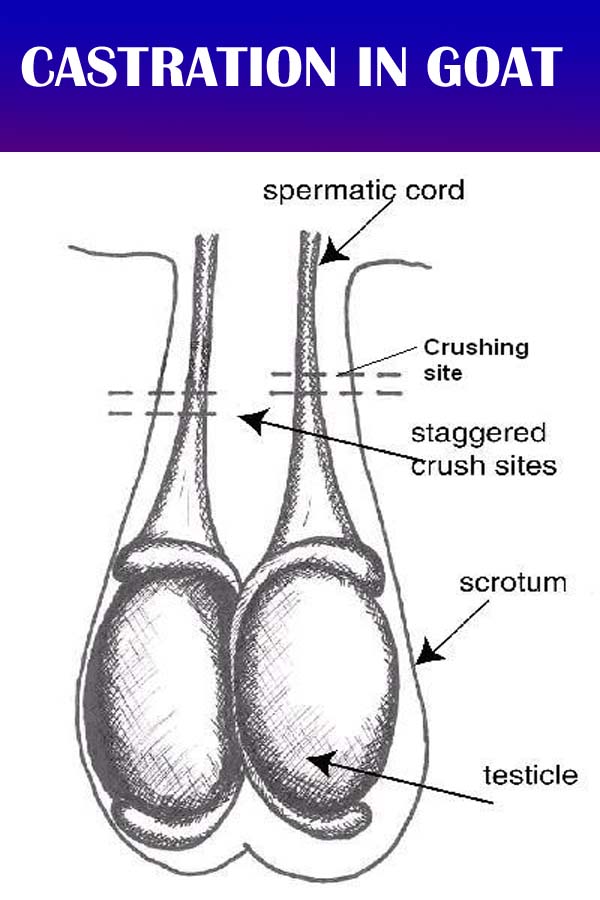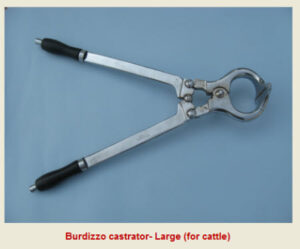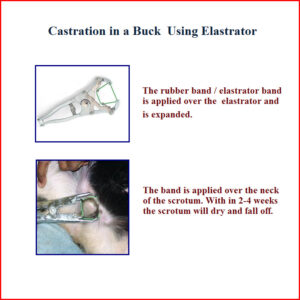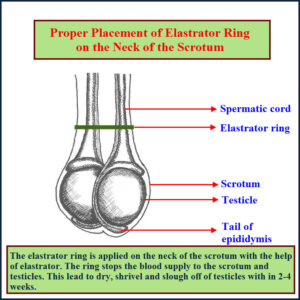CASTRATION IN SHEEP & GOAT
Castration is the destruction or removal of the testicles of the male. It is carried out on animals which are not wanted for breeding.
Castration of cattle, sheep, and goats has traditionally been a routine part of livestock husbandry. It avoids unwanted pregnancies and reduces aggression towards humans and other animals. Castration can improve meat quality by increasing the distribution of fat, improving tenderness (cattle and sheep) ,avoiding undesirable odours and flavour (rams and goats) and reducing the occurrence of dark-firm-dry meat (cattle) . However, intact animals are more efficient at converting feed into lean meat and castration is not necessary for all systems of management, such as the rearing of lambs for slaughter before they reach sexual maturity and in veal cattle production.
Castration is performed by surgical removal of the testicles, or by techniques that cause restriction of the blood supply and testicular necrosis (e.g., rubber rings, bands, and Burdizzo/clamp) . Castration without anaesthesia and analgesia causes acute and chronic pain . Depending on the methods used, there is also a risk of complications, such as infection, fly strike, and haemorrhage . The risk of incomplete castration is lowest after surgery; it is intermediate after the use of a rubber ring, and greatest after the use of a Burdizzo/clamp.
Purpose
|
Precaution
- Castration should be performed during cold season and strictly avoid rainy season for fear of fly problems.
- Castrated animals should be rested for few days in clean and comfortable pens.
Optimum Age
- Young animals: within 3 months (Surgical method and elastrator)
- Adult animal: within one year of age (Closed method – Burdizzo castrators)
Methods
Burdizzo method
-
- It is also known as bloodless castration. The Burdizzo castrator is used to crush the spermatic cord and thus stopping the blood to the testes.
- This results in atrophy of the testes and stoppage of spermatozoa production.
- After casting, secure the animal. Move the spermatic cord to the side of the scrotum and then clamp the Burdizzo at about 3-5 cm above the testicles and it is held for a few seconds.
- Then repeat this operation on the same cord at a location about 1cm below the first one. This method is safe, quick and less chance of getting infection.
- Open or surgical method
- Scrotum is opened and testicles are removed, aseptically and the wound is treated with antiseptics.
- In young bulls the cord may be cut as savagely off but in the case of mature bulls the cord should be twisted before severing it.
- Rubber ring or elastrator method
- A strong and tight rubber ring placed around the cord at an early age of calf.
- This creates constant pressure and the testicles are atrophied and absorbed and the ring drops down.
- Elastrator rings are very painful to the animal and so it is not usually recommended. Optimum age: below 3 months.
Why do we castrate animals?
- Traditionally farmers or animal raisers do not castrate animals and both males and females are allowed to mix together.
- The result is that poor males are allowed to mate with the females and the young stock produced are not very good.
- Uncastrated males also fight so it is better to castrate the animals which are not the best for breeding.
When do we castrate animals?
The best time to castrate animals is when they are very young (a few days old). If castration is carried out then, the operation is easier and more successful and the wound heals (gets better) very quickly.
Holding and controlling animals for castration
You will need another person to help you. It is best to put young lambs and kids on a table covered with sacks. Calves can be castrated when they are standing but the animal must be restrained very well.
Holding and controlling animals for castration
Castration with a knife (blood)
Use a very sharp knife, razor or scalpel.
- Check that the knife, razor or scalpel is very sharp and clean. Clean the blade with a disinfectant such as alcohol, iodine, Dettol or gentian violet.
- Use warm water and soap to wipe the scrotum and wash your hands.
- Cut the bottom end of the scrotum. Squeeze the testicle above the cut end of the scrotum and it will come out.
- Pull each testicle out as far as possible, twist the testicular cord around several times. Cut the cord in cattle and buffalo by scraping the knife slowly up and down. Pull to sever the cord in lambs and kids.
- Do not put your fingers inside the open scrotum. Put either tincture of iodine, gentian violet, Dettol or antibiotic powder on the wound.
Castration with burdizzo (no blood)
The Burdizzo should be used on the young animal. There are Burdizzos for animals of different sizes. You should always remember that the Burdizzo is a valuable instrument and keep it clean and oiled. Do not drop it.
To castrate with the burdizzo:
- Feel the scrotum with your hand and you will feel the two rope-like testicular cords inside.
- Take the Burdizzo in your right hand and with your left hand push the cord to the side between the jaws of the Burdizzo and squeeze hard.
- Now take the Burdizzo in the left hand and crush the other cord.
Castration with rubber rings
To castrate with rubber rings, we use a tool called an elastrator. It can only be used to castrate ruminants which are a few days old.
- Put a rubber ring around the four teeth of the elastrator and squeeze the handle. The rubber ring will be stretched open.
- Pass the scrotum of the animal through the ring making sure that it goes over the two testicles.
- Release the elastrator and the rubber ring will tighten over the cords. After two weeks, the scrotum will fall off.
Castration with rubber rings
Check all animals which have been recently castrated for signs of infection.
Aftercare needed:
The following care should be taken after castration of the animals:
- Turn calves in with their mothers in a clean grass pen.
- Do not turn into muddy or filthy lots or lots around barns (where there is much danger of infection).
- Watch the animal closely for about 10 days after castration.
- Beware of fly attacks and infection (especially with emasculator method).
- Treat wounds with wound aerosol which discourages fly attacks.
- If swelling and pain are severe and/or if the animal develops fever, a suitable antibiotic should be injected.
Reference-on request








